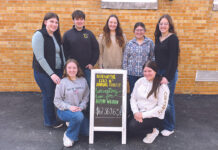
LITTLE HOCKING, Ohio — Jamey and Jody Rauch, of Rauclif Farms, know all too well the difficulties farm life presents. But through the struggles and triumphs, farm life is what they were made for.
“This is all I wanted to do,” Jamey said, sitting at his kitchen table, hands clasped on the hardwood surface and sharing memories of working alongside his father. “If the truck was leaving, I thought that truck couldn’t run without me in the passenger seat.”
For Jamey’s wife, Jody, however, life on the farm was a brand new experience.
“It felt like I was coming into another country. The culture shock was enormous, and it was different from anything I knew,” she said.
Jamey and Jody met while attending Ohio State’s Agricultural Technical Institute in Wooster. Jamey said after taking her to visit the farm, he had her hooked. She had fallen in love with the rolling farmland and peacefulness of the countryside even though she knew nothing about farming.
Today, they say it’s a perfect place to raise their four children who have all learned their roles on and off the farm.
Rauclif Farms, in Little Hocking, Ohio, in Washington County, is divided among five properties, totaling around 1,000 acres of pasture land, row crops and hay. The Rauchs also raise 100 head of commercial beef cattle, and are being honored Jan. 23 at the Ohio Cattlemen’s Association annual banquet as the Commercial Producer of the Year, an award sponsored by Farm and Dairy.

Lessons learned
The Rauch family has learned its share of lessons over the years, but none has been more eye-opening than a time Jamey calls “the dark ages.”
In the late 1980s and early ’90s, the Rauch family had maxed out its feedlot at around 600 head when disease rolled through the herd. To make matters worse, bad weather crippled crop yields.
“We really struggled … made poor decisions …,” said Jamey. “It taught us piles,” added Jody.
Neither admitted to being good at keeping records in those early years, but reaching out for help was one of the best decisions they made. They looked to personal advisers, to Extension specialists and even God.
Less is more
The hard times forced the Rauchs to do some serious evaluations of the herd. “Just because the cow has bedroom eyes and is my most favorite cow in the whole lot, if she is not producing, we can’t hang on to it,” said Jamey.
“We went through our whole farm that way, trying to figure out why it wasn’t working and trying to make it work.” Keeping their herd to around 100 head has made the farm more manageable, especially with limited family labor.
Stewards of the land
“Conservation is ingrained in our everyday life,” said Jamey, giving credit to his father for instilling those values in his family early on. To keep his soil healthy, the family uses cover crops and takes soil samples to help evaluate the land. Implementing heavy use pads for feeding, spring tanks and rotational grazing all help to extend the life of the pasture land. By using as many acres as possible for alternative forage, the family is able to extend the grazing season for their cattle.
Jamie noted the water tends to run brown in the Little Hocking Watershed. “I don’t want my farm to be the reason that it is brown,” he said. Fencing out waterways, developing a manure storage system, using little to no tilling and spreading seed and mulch to prevent runoff are some ways Jamey has contributed to the area’s natural resources conservation.
Livestock care
From the land to the livestock, “we are always trying to do things better,” he said. That includes their genetics and breeding program. Setting benchmarks and keeping records on their breeding program has helped get them on track for a 45-day calving season. So far, 80 percent of the cows birth within this time frame.
Animal husbandry and care is important to Jamey and his family. “We will go without supper before they do,” he said. He added they work quietly when it comes to moving and loading cattle, and they don’t tolerate truck drivers who do not show the same respect to the cattle that they do. “An animal should only have one bad day in its life and that’s when it is harvested,” said Jamey.
Farm roles

Relying on only family labor, and not having much of it around, makes everyone a multitasker when it comes to their roles on the farm.
“There is a system now. Everyone has a job and we know what our jobs are,” said Katie Marks, Jamey and Jody’s oldest daughter. Katie finds herself mostly caring for the livestock and helping with the record keeping.
During the harvest months, it is “all hands on deck,” and can mean up to four tractors working the fields at a time. Their sons, Josh and Evan, enjoy the field work, “maybe a little bit more than working with the cattle,” said Jamey.
“Everyone has to muscle their way in,” added Jody, who found herself not only muscling her way in but learning it all on the fly. Only their second oldest, Kendra, found her calling away from the farm, serving in the U.S. Navy. “She’s our eyes on the world,” said Jamey.
Jamey’s parents, Bernard and Jane, are in their 80s now, but “Dad’s out there every day,” he said. Jane, on the other hand, enjoys sitting on her front porch and watching the farm come to life, with the seventh and eighth generations running the farm.
“I wouldn’t trade it for anything. It is beautiful,” said Jody.









